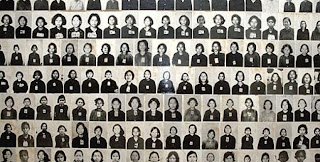The Khmer Rouge period (1975–1979) refers to the rule of Pol Pot, Nuon Chea, Ieng Sary, Son Sen, Khieu Samphan and the Khmer Rouge Communist party over Cambodia, which the Khmer Rouge renamed as Democratic Kampuchea.
The four-year period cost approximately 2 million lives through the combined result of political executions, starvation, and forced labour.Due to the large numbers, the deaths during the rule of the Khmer Rouge are often considered a genocide, and commonly known as the Cambodian Holocaust or Cambodian Genocide. The Khmer Rouge period ended with the invasion of Cambodia by neighbour and former ally Vietnam in the Cambodian–Vietnamese War, which left Cambodia under Vietnamese occupation for a decade.
The Khmer Rouge government arrested, tortured and eventually executed anyone suspected of belonging to several categories of supposed "enemies":
Following were the reasons to be discriminated against :
Anyone with connections to the former government or with foreign governments.
Professionals and intellectuals in practice this included almost everyone with an education, or even people wearing glasses (which, according to the regime, meant that they were literate). Ironically and hypocritically, Pol Pot himself was a university-educated man (albeit a drop-out) Many artists, including musicians, writers and film makers were executed. Some like Ros Sereysothea, Pan Ron and Sinn Sisamouth gained posthumous fame for their talents and are still popular with Khmers today.
Ethnic Vietnamese, ethnic Chinese, ethnic Thai and other minorities in Eastern Highland, Cambodian Christians (most of whom were Catholic, and the Catholic Church in general), Muslims and the Buddhist monks.
"Economic saboteurs:" many of the former urban dwellers (who had not starved to death in the first place) were deemed to be guilty by virtue of their lack of agricultural ability.
Some 57,000 people passed through Tuol Sleng Centre (also known as S-21) before they were taken to sites (also known as The Killing Fields), outside Phnom Penh such as Choeung Ek where most were executed (mainly by pickaxes to save bullets) and buried in mass graves. Of the thousands who entered Tuol Sleng only twelve are known to have survived.
Today, examples of the torture methods used by the Khmer Rouge can be seen at the Tuol Sleng Genocide Museum. The museum occupies the former grounds of a high school turned prison camp that was operated by Khang Khek Ieu, more commonly known as "Comrade Duch".
Modern research has located over 1,000,000 mass graves from the Khmer Rouge era all over Cambodia. Various studies have estimated the death toll at between 740,000 and 3,000,000, most commonly between 1.4 million and 2.2 million, with perhaps half of those deaths being due to executions, and the rest from starvation and disease.
The U.S. State Department-funded Yale Cambodian Genocide Project estimates approximately 1.7 million.R. J. Rummel, an analyst of historical political killings, gives a figure of 2 million.
A UN investigation reported 2–3 million dead, while UNICEF estimated 3 million had been killed. Demographic analysis by Patrick Heuveline suggests that between 1.17 and 3.42 million Cambodians were killed.
The Khmer Rouge banned by decree the existence of ethnic Chinese, Vietnamese, Muslim Cham, and 20 other minorities, which altogether constituted 15% of the population at the beginning of the Khmer Rouge's rule.
The UN General Assembly voted overwhelmingly for the Khmer Rouge to retain their seat at the UN. The seat was occupied by Thiounn Prasith, an old cadre of Pol Pot and Ieng Sary from their student days in Paris and one of the 21 attendees at the 1960 KPRP Second Congress. The seat was retained under the name 'Democratic Kampuchea' until 1982 and then 'Coalition Government of Democratic Kampuchea' until 1993.
Hall of Shame
Pol Pot (19 May 1925 – 15 April 1998),born Saloth Sar Pol Pot Khmer was a Cambodian Maoist revolutionary who led the Khmer Rouge from 1963 until his death in 1998.
Pol Pot became leader of Cambodia on April 17, 1975, and his rule has been described as being a dictatorship.During his time in power he imposed agrarian socialism, forcing urban dwellers to relocate to the countryside to work in collective farms and forced labor projects. The combined effects of forced labor, malnutrition, poor medical care, and executions resulted in the deaths of approximately 21 percent of the Cambodian population. In all, an estimated 1 to 3 million people (out of a population of slightly over 8 million) died as a result of the policies of his three-year premiership.
In 1979, after the Cambodian–Vietnamese War, Pol Pot fled to the jungles of southwest Cambodia, and the Khmer Rouge government collapsed. From 1979 to 1997, he and a remnant of the old Khmer Rouge operated near the border of Cambodia and Thailand, where they clung to power, with nominal United Nations recognition as the rightful government of Cambodia. He died at age 73 reasons unkown.
Ratiocination :
Innocent civilians were discriminated for their ethnicity and their decree of existence was a sin to these governments.
Isnt any government obligated to take care of its citizens or take the very life of its citizens ??A government must not enslave us from our privileges rather enslave themselves to reach out to all our needs and safety.
No justice was brought to these perpetrators rather they were re elected by the support of the UN and USA and brought back to power.
This genocide and every other one that took place in the history of mankind was funded and backed by the true conspirators.
People wake up from your subconcious state of sleep and dont be in denial of facts .Acknowledge them and be prepared and fight for your rights.
For this is the real face of todays governments where they suck your blood and make you weak and why are you not resisting ? why are you not revolting? to the very crimes of your own governments in your countries..
FIGHT FOR YOUR RIGHTS























No comments:
Post a Comment